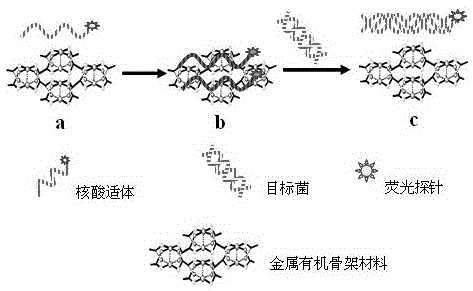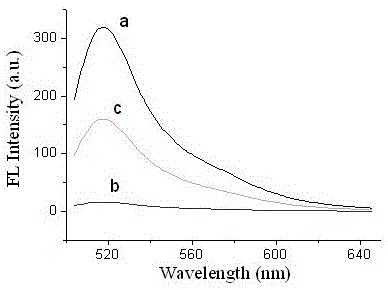Method for detecting food-borne pathogenic bacteria on basis of metal organic framework material and aptamer fluorescence sensor
A metal-organic framework, food-borne pathogenic bacteria technology, applied in the field of food-borne pathogenic bacteria analysis and detection, can solve the problems of cumbersome and time-consuming operation, low sensitivity, and low specificity of pathogenic bacteria detection technology.
- Summary
- Abstract
- Description
- Claims
- Application Information
AI Technical Summary
Problems solved by technology
Method used
Image
Examples
Embodiment 1
[0020] Example 1: Application of the method of the present invention in the detection of Salmonella
[0021] First synthesize organic framework materials containing Cd, the process is as follows:
[0022] Step 1: Add CdCl 2? 2.5H 2 O (0.046g, 0.2mmol) and H 2 BTC (0.105g, 0.5mmo) was dissolved in 8.0mL of DMF, 3.0mL of cyclohexanol and 2.0mL of water, mixed and stirred at room temperature for 4 hours, for later use.
[0023] Step 2: Transfer the solution obtained in step 1 to a beaker, and slowly add 0.2 mL of triethylamine dropwise while stirring. After 10 minutes, the dropwise addition is complete. Seal the large beaker with a plastic film and place the beaker in an ultrasonic reactor at 60°C Ultrasound for 15 minutes. The product was taken out by centrifugal filtration, washed with 60 mL DMF, and dried under vacuum at 70°C for 24 hours to obtain [Cd 4 (BTC) 3 (DMF) 2 (H2O) 2 ] Porous Cd-containing organic framework materials.
[0024] The Cd-containing organic framework material ...
Embodiment 2
[0029] Example 2: Application of the method of the present invention in detecting Salmonella and other pathogenic bacteria
[0030] In order to evaluate the specificity of the method of the present invention, common food-borne pathogens in food such as Salmonella, Staphylococcus aureus, Escherichia coli, Shigella and Listeria were selected, and the detection steps described in Example 1 were followed. Measure these pathogenic bacteria, record their respective fluorescent signals and compare them, the results are as follows Figure 4 Shown. Since the target bacteria of the aptamer is Salmonella, Salmonella (5.5 × 10 3 cfu / mL) has the strongest fluorescence signal, while other pathogenic bacteria at a concentration of 10 times that of Salmonella, the fluorescence intensity is one-tenth or even lower than that of Salmonella. This result shows that the method based on metal organic framework material-nucleic acid aptamer fluorescence sensor to detect pathogenic bacteria is highl...
Embodiment 3
[0031] Example 3: The method of the present invention is applied to the detection of Salmonella in beef samples
[0032] Ground 10g of frozen fresh beef, homogenize it with 100mL Tris-HCl (pH 7.4) buffer solution for 15 minutes, filter to remove large particles and suspended matter, take the supernatant for use, and determine the supernatant according to the detection procedure described in Example 1. Salmonella in the serum. Take 5 beef samples for parallel testing.
[0033] Different concentrations of Salmonella (1.0 × 10) were injected into the supernatant of 5 beef samples. 3 ~ 5.0 × 10 3 cfu / mL), each concentration was confirmed by the plate counting method, and then the Salmonella in the sample was detected again according to the detection steps described in Example 1. The detection results are shown in Table 1. Salmonella was not detected in 5 beef samples, the relative standard deviation (RSD) of the spiked experiment was 3.6% ~ 7.5%, and the recovery rate was in the range...
PUM
 Login to View More
Login to View More Abstract
Description
Claims
Application Information
 Login to View More
Login to View More - R&D
- Intellectual Property
- Life Sciences
- Materials
- Tech Scout
- Unparalleled Data Quality
- Higher Quality Content
- 60% Fewer Hallucinations
Browse by: Latest US Patents, China's latest patents, Technical Efficacy Thesaurus, Application Domain, Technology Topic, Popular Technical Reports.
© 2025 PatSnap. All rights reserved.Legal|Privacy policy|Modern Slavery Act Transparency Statement|Sitemap|About US| Contact US: help@patsnap.com



